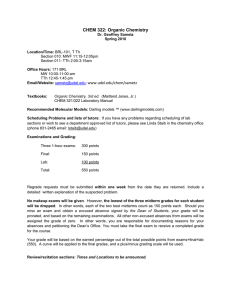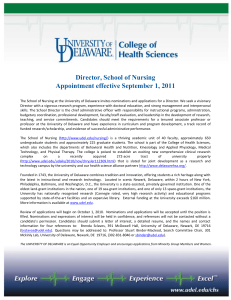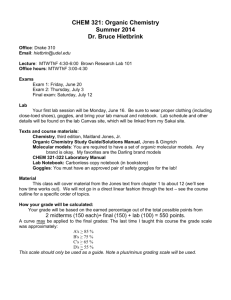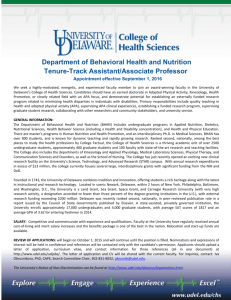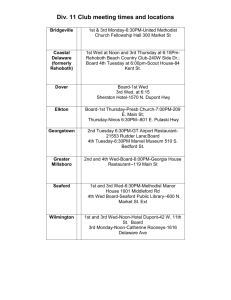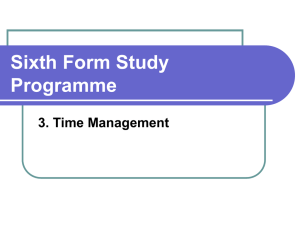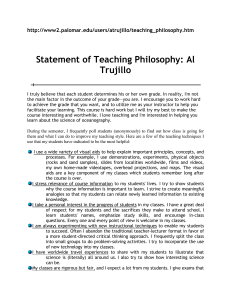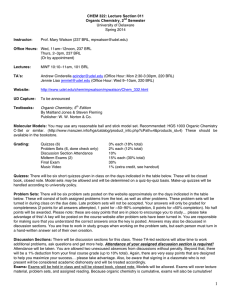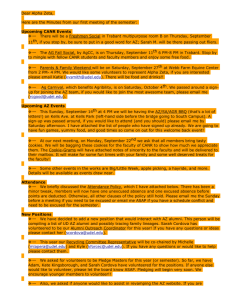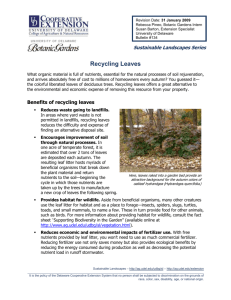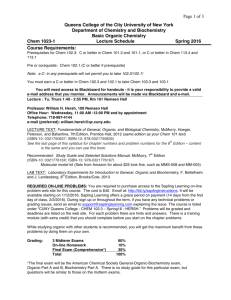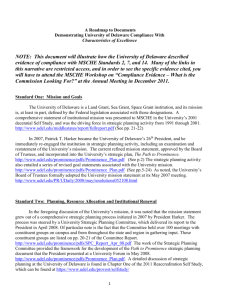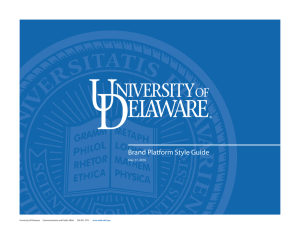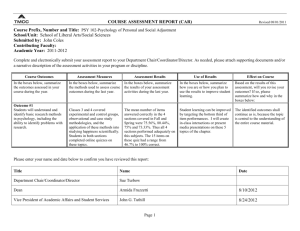CHEM 321/322 Laboratory Manual
advertisement
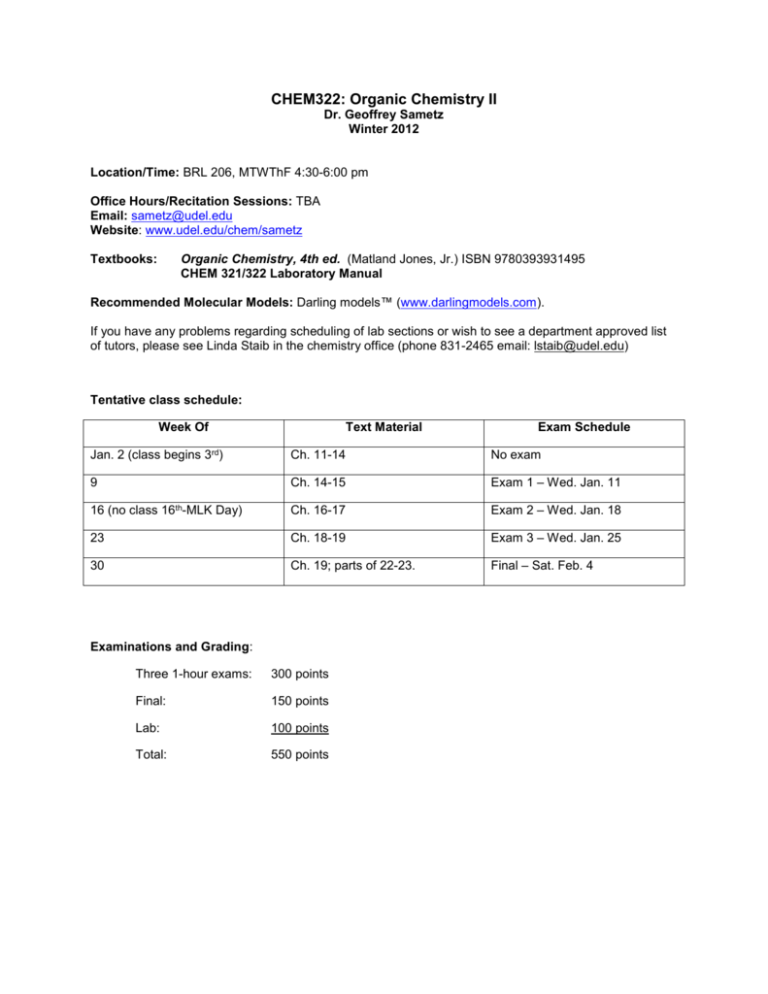
CHEM322: Organic Chemistry II Dr. Geoffrey Sametz Winter 2012 Location/Time: BRL 206, MTWThF 4:30-6:00 pm Office Hours/Recitation Sessions: TBA Email: sametz@udel.edu Website: www.udel.edu/chem/sametz Textbooks: Organic Chemistry, 4th ed. (Matland Jones, Jr.) ISBN 9780393931495 CHEM 321/322 Laboratory Manual Recommended Molecular Models: Darling models™ (www.darlingmodels.com). If you have any problems regarding scheduling of lab sections or wish to see a department approved list of tutors, please see Linda Staib in the chemistry office (phone 831-2465 email: lstaib@udel.edu) Tentative class schedule: Week Of Text Material Exam Schedule Jan. 2 (class begins 3rd) Ch. 11-14 No exam 9 Ch. 14-15 Exam 1 – Wed. Jan. 11 16 (no class 16th-MLK Day) Ch. 16-17 Exam 2 – Wed. Jan. 18 23 Ch. 18-19 Exam 3 – Wed. Jan. 25 30 Ch. 19; parts of 22-23. Final – Sat. Feb. 4 Examinations and Grading: Three 1-hour exams: 300 points Final: 150 points Lab: 100 points Total: 550 points The lowest of the three midterm grades for each student will be dropped. There are NO “make-up” exams. If you have an excusable absence (e.g. documented illness or death of family member), your grade will be curved to accommodate the absence. All other non-excused absences from exams will be assigned the grade of zero. You must take the final exam to receive a completed grade for the course. Your grade will be based on the earned percentage out of the total possible points from exams+final+lab (550). A curve will be applied to the final grades, and a plus/minus grading scale will be used. The following grade cutoffs (percentage of total points) were used in the fall of 2009 for CHEM321, and are shown only to give an indication of what score is typical to get a certain grade. The exact cutoffs for this semester will not be determined until after the final exam. A AB+ B BC+ C CD+ D D- 85-100 79-85 77-79 72-77 69-72 (The average was a B-) 67-69 63-67 60-63 58-60 50-58 47-50 25% of the class got As; 38% Bs, 20% Cs, 16% Ds, 1% F. REGRADING POLICIES If you believe that there is an error in the grading of your exam, you may submit it for regarding. The following protocol MUST be followed: 1. Regrade requests must be submitted within one week from the date they are returned to you. 2. You must include with your paper a written account of which questions you want regraded, and why (e.g. “adding error”). 3. You must sign your name to the written account mentioned above. IT IS A VIOLATION OF BOTH THIS POLICY AND THE UNIVERSITY OF DELAWARE HONOR CODE TO CHANGE ANSWERS ON YOUR EXAMINATION BEFORE SUBMITTING THE EXAMINATION FOR REGRADING. It is standard policy to make double-sided copies of selected exams and to compare these copies with resubmitted exams. Students who alter an exam answer and submit it for regrade will be prosecuted through the University of Delaware Office of Student Conduct. It is strongly recommended that you either refrain from making study notes on your original exam, or to use a different color ink or pencil to delineate your notes from your original answer. This will ensure that, should you wish to have a question regraded, that you will not run afoul of this policy. ACADEMIC MISCONDUCT Other violations of the University of Delaware’s Code of Conduct (e.g. copying or use of “cheat sheets” during examinations) will be prosecuted through the University of Delaware’s Office of Student Conduct. CHEM 322 Course Learning Goals After successful completion of this course, a student should be able to: 1. Describe the frontier molecular orbitals for conjugated π-systems and carbonyl compounds. (1)* 2. Understand the stabilizing effect of conjugation on electrons in π-bonds. (1) 3. Predict products, propose reaction conditions, and draw arrow-pushing mechanisms for reactions of dienes and allyl systems. (1) 4. Understand the concept of aromaticity. (1) 5. Predict products, propose reaction conditions, and draw arrow-pushing mechanisms for reactions of aromatic systems. (1) 6. Determine the identity of a chemical compound based on spectroscopic data. (1, 6) 7. Predict products, propose reaction conditions, and draw arrow-pushing mechanisms for reactions of carbonyl compounds. (1) 8. Predict products, propose reaction conditions, and draw arrow-pushing mechanisms for reactions of carboxylic acids and their derivatives. (1) 9. Understand the biological importance, structure and reactivity of carbohydrates and sugars. (1) 10. Understand the biological importance, structure and reactivity of amino acids. (1) 11. Safely perform a chemical reaction in a laboratory, making qualitative and quantitative observations of the experiment. (2, 6, 7, 8) 12. Prepare a laboratory report of an experiment they have performed. (10) (*Numbers in parentheses indicate the departmental learning goals with which each course goal is aligned. Please see: http://www.udel.edu/chem/goals.html.)
